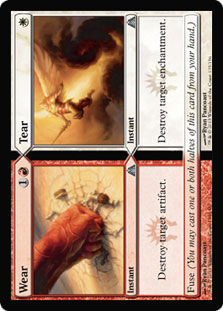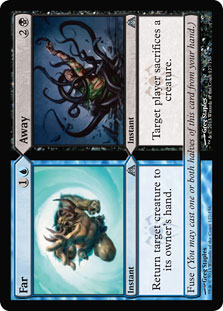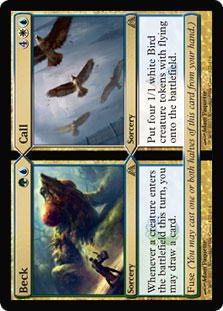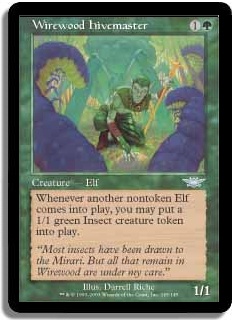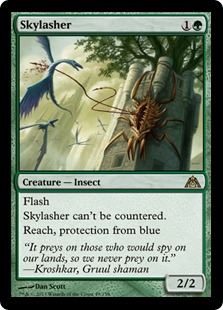At its core, Dragon’s Maze is a multicolored set. More than half of the colored spells are gold, almost all of the lands are reprints, and all of the artifacts are revamped Keyrunes. By any metric, this is a set that is heavily pointed toward Limited.
It is tempting to look at multicolored sets and think of all of their potential Legacy applications. After all, Legacy is the format where you can play whatever mana base you want, right? Fetchlands and dual lands make it easy to splash gold cards—people are playing Jace, the Mind Sculptor and Lingering Souls together! How hard can it be?
As it turns out, it’s really hard to be a playable gold card in Legacy. This is not to say that it’s impossible, but the bar is very high. Let’s look at the best gold cards in Legacy tournaments as of late:
Abrupt Decay: The best two mana removal spell in the format. Lines up favorably against perennial utility standby Vindicate, as it’s an instant, costs two, and cannot be countered. Vindicate’s upsides involve killing Jace, the Mind Sculptor and killing opponents who miss their second land drop.
Knight of the Reliquary: Although it has fallen out of favor somewhat with the printing of Lingering Souls and even more so with Deathrite Shaman, Knight of the Reliquary used to be the go-to Tarmogoyf trump. If you want to compare Knight of the Reliquary to another gold card that received a lot of hype, check out Lorescale Coatl. Both are 1CD 2/2s with an ability that makes them get bigger, but Lorescale Coatl was quickly proven to be unplayable. Why?
Because Knight of the Reliquary does something every turn.
Sometimes you need to find a sweet land—it does that. Sometimes you want a huge attacker—it does that. Sometimes you want to shuffle your deck because you cast Ponder last turn or Brainstorm this turn—it does that. There are a lot of game states where Knight of the Reliquary is useful. There are far fewer game states where Lorescale Coatl is useful. We see that again with:
The Planechase Twins – Baleful Strix and Shardless Agent: Both basically read “passable creature plus draw a card.” Baleful Strix is an honest version of that text box, while Shardless Agent is a scoundrel’s version of that text box. The best-case scenario for each involves trading for a creature and either drawing into or freerolling some sweet spell. As with Knight of the Reliquary, the worst case isn’t bad, and the upside is huge.
Lingering Souls: Literally blank against noncreature decks and quite good everywhere else. At worst, you’re chump blocking a Tarmogoyf for four turns, in which case your five mana probably netted you around fifteen life, which converts into whatever you did with all the time that that fifteen life bought you (Jace activations, Brainstorms, whatever). At best, it kills your opponent by leveraging your ability to do basic combat math, activate the equip ability on Umezawa’s Jitte, and blindly activate Umezawa’s Jitte after it has counters on it. Much like with Jace, it’s really hard to activate any of Umezawa’s Jitte’s abilities at any point and lose.
Deathrite Shaman: Does everything. There is basically no game state where if you’re playing Magic Deathrite Shaman is not doing work for you. You have to really work to imagine a world in which you cast a Deathrite Shaman, get the turn back, and sigh with unhappiness. It probably involves not having a second land, which isn’t really the Deathrite Shaman’s fault.
[Editor’s Note: It is always Deathrite Shaman’s fault.]
There are a bunch of existing gold cards that are both good and yet not good enough. For instance, when was the last time that anyone saw Pernicious Deed in play? It’s a phenomenally powerful card, but time has somewhat passed it by. Gaze of Granite is a tribute to Pernicious Deed (and Dissension tribute Crime / Punishment), but we can’t reasonably expect to play a callback version of a card that isn’t going in our top tier Bayou decks.
On a similar note, we can’t realistically expect to play Varolz, the Scar-Striped (and awesome tagalongs Death’s Shadow and Phyrexian Dreadnought) when our graveyard-based decks functionally kill on turn 2. I mean, if you’re going to cast Buried Alive for three cards, why get Varolz, the Scar-Striped / Death’s Shadow / Death’s Shadow when you could get Necrotic Ooze / Phyrexian Devourer / Triskelion? For that matter, why play a value-based graveyard strategy at all when Past in Flames, Griselbrand, and Golgari Grave-Troll all exist?
My point is that past sets have created a high bar for Legacy playability in gold sets. It is with this mentality that we ought to look at Dragon’s Maze—we should be innovative but not overly optimistic.
The first trio of cards that I want to talk about all have the fuse mechanic. Fuse is a split card mechanic that reads:
You may cast one or both halves of this card from your hand.
For the rules junkies:
- You can Snapcaster either side of a Fuse card but not both.
- You can cascade into either side of a Fuse card but not both. For instance, you can Shardless Agent into Beck // Call and cast the Call half. You won’t get to draw cards off of your Birds, but you will get most of an Ordered Migration.
The first fuse card that stands out to me is Wear // Tear.
There isn’t a lot of explaining to do with this humble card. It’s going to replace Disenchant in any Legacy sideboard that can produce red mana. I don’t think it’s better than Aura of Silence on a raw power level, as it is a near-win against Storm. Still, it will see a tiny amount of play and may get to live the once-in-a-lifetime dream of killing both a Batterskull and a Counterbalance. Its caster will probably still lose the game to the superior card quality provided by the opposing Sensei’s Divining Top, but not all dreams end in victory. Wear // Tear never promised you the world; it only promised that it would do its job.
The second fuse card to catch my eye is the equally workmanlike Far // Away.
This time “the dream” involves picking up your Snapcaster Mage (or Shardless Agent) and dealing with their Emrakul, the Aeons Torn. Do note that you can cascade into Far // Away and cast Away for those of you who dream of doing Really Cool Things that you then need to Explain To Your Opponents.
I would not recommend playing this card as a value-based removal spell against low-curve opponents, as you are likely to either never be able to cast the five mana version because of Wasteland or will get the five mana version Dazed and immediately die to Delver of Secrets plus Tarmogoyf.
In other words, this card is at its best on a board of exactly [your value creature] and [their huge untargetable monster and no other creatures]. A narrow application, to be sure, but worth considering if you were already in the market for a Diabolic Edict type effect.
The last fuse card is also my pick for most Legacy playable card in the set, Beck // Call.
Really, though, this is just about Beck. Call is a strict hindrance in Legacy, as people are more likely to want to play Dark Confidant with Beck than play cascade spells to cast Call. Flipping Beck // Call with Dark Confidant, for the uninitiated, will cost you eight life points.
Fortunately, I don’t think Beck // Call wants to go into a deck with Swamps. There’s a very natural fit for Beck already:
Wirewood Hivemaster was how Extended Elves decks of yore beat attrition-based blue decks. A blue deck would play a sweeper, the Elves deck would play a Hivemaster and a Wirewood Symbiote, and two turns later the blue player would have to play another sweeper. The Elves player would then Wirewood Symbiote their Wirewood Hivemaster, and the cycle would begin anew.
Of course, this time you get to draw a bunch of cards off of your Insects.
As a foreword, I am unsure of a world in which it is better to have Beck // Call than Natural Order, but it is impossible to play both, play Glimpse of Nature and Green Sun’s Zenith (your two best cards), and still have enough creatures in your deck. It’s a similar deckbuilding problem to the one that you encounter with Delver of Secrets: you want to play a bunch of sweet spells to go with your creatures, but you can’t play too many or your good cards get worse. The problem is magnified in Elves because while you can keep a hand of four creatures in a Delver deck, you can’t keep a hand of three lands and four spells in an Elves deck.
With that out of the way, let’s look at what a Beck // Call Elves deck would look like:
4 Glimpse of Nature
4 Green Sun’s Zenith
4 Beck // Call
The good spells.
4 Deathrite Shaman
4 Nettle Sentinel
4 Heritage Druid
4 Wirewood Symbiote
4 Elvish Visionary
The good creatures.
The other 28 slots are up for debate and will involve sixteen-to-eighteen lands, but we can learn a lot from previous versions:
- Natural Order Elves plays four Quirion Rangers because it can produce two mana in a turn, which is important if you’re in the business of getting to four mana very quickly. It also lets you double up on Deathrite Shaman activations, which makes the possibility of cutting them fairly untenable. After all, if Deathrite Shaman is one of the best cards in the format, why are we cutting our best enabler? And if we’re playing four Quirion Rangers, why aren’t we playing Natural Order?
- Nobody plays more than two Priest of Titanias since it’s only really good if you’re winning or if you’re facing down a The Tabernacle at Pendrell Vale. Given how many attrition-based decks you’re likely to face in the course of a tournament and how few Tabernacles exist, I’d focus more on beating Hymn to Tourach and focus less on beating the one person playing Lands in the state.
- Numbers on Birchlore Rangers vary. It’s likely that we want more given that a key component of the deck is a non-green spell. Older Mirror Entity based lists played two or three Birchlore Rangers so that they could reliably cast their Mirror Entity, but casting Beck will be even more important.
- Numbers on Llanowar Elves / Fyndhorn Elves have varied as well, but it’s likely that we want more of these if we want to use Beck as a two mana Glimpse of Nature.
- Gaea’s Cradle is your best land. Play four.
- You want at least thirteen and probably fourteen first turn green sources.
- Dryad Arbor numbers vary, but if you’re playing Beck you’ll probably want two and more fetchlands since Beck can be a Divination with upside from a flooded hand.
- Wirewood Hivemaster is a take-it-or-leave-it card. It has almost never shown up in Legacy Elves, but that was always due to the nature of Elves hate. When people play a card to beat Elves, it’s typically Engineered Plague. Wirewood Hivemaster is poor against Engineered Plague, and the inclusion of Beck is already pushing the mana curve up, so I’ll draw up two lists—one with Wirewood Hivemaster and one without:
Creatures (29)
- 1 Llanowar Elves
- 4 Wirewood Symbiote
- 1 Quirion Ranger
- 3 Wirewood Hivemaster
- 2 Birchlore Rangers
- 1 Mirror Entity
- 4 Heritage Druid
- 4 Nettle Sentinel
- 1 Regal Force
- 4 Elvish Visionary
- 4 Deathrite Shaman
Lands (19)
Spells (12)

A few side notes:
- This is going to be worse against combo and many control decks than Natural Order Elves, as you no longer have a quick “Natural Order for Craterhoof Behemoth” kill or a near-unbeatable “Natural Order for Progenitus” midgame.
- You’re more vulnerable to Wasteland than any version of Elves has ever been.
- There are many ways to go infinite with Mirror Entity. For a more thorough primer, I suggest reading Chris Andersen excellent article on Elves here.
- It’s adorable that you get an Insect off of opposing Deathrite Shamans.
- It’s possible that you want Crop Rotation over a Gaea’s Cradle since Crop Rotation draws a card (off of Dryad Arbor) with Beck active while still finding a Gaea’s Cradle in mana-starved situations.
Creatures (27)
- 2 Llanowar Elves
- 4 Wirewood Symbiote
- 1 Quirion Ranger
- 2 Birchlore Rangers
- 1 Mirror Entity
- 4 Heritage Druid
- 4 Nettle Sentinel
- 1 Regal Force
- 4 Elvish Visionary
- 4 Deathrite Shaman
Lands (20)
Spells (13)

There are, of course, many more implementations of Beck in Modern. I’m sure you’ve noticed that Narcomoeba and Bridge from Below are both Modern-legal cards…
Staying in Legacy for a bit longer, we have an update on the “keyword soup hoser creature,” Skylasher.
Four abilities, all of them relevant in Legacy. Before getting to its upside, let’s set our expectations somewhere realistic.
Skylasher still dies to every removal spell currently played in Legacy. It does not favorably interact with Tarmogoyf, Nimble Mongoose, or any Equipment. If attacking, it will trade with half of a Lingering Souls. It is an embarrassing clock against a combo deck.
With that said, it eats Delver of Secrets, Snapcaster Mage, Geist of Saint Traft, Shardless Agent, Baleful Strix, Vendilion Clique, and any solo Merfolk. It cannot be Jaced or Submerged, and Spirits from Lingering Souls can’t profitably attack into it without Equipment.
I don’t believe this card is maindeckable mostly because it’s not a real threat. It’s an answer that happens to be a creature, which is where R&D allocates most of Magic’s complexity points and power level nowadays.
There is a point at which the card “Grizzly Bears” gets enough abilities to be worth playing. I don’t believe that day has come, but there will be people who will play it because it is a direct solution to what ails them. If there is a reason to play this card, it is because you are a green deck that can beat RUG Delver on the ground but keeps losing to it in the air. I would not play this if you want to beat any Esper deck, as you are more likely to lose to their black cards than their blue cards if you’re a green mage in Legacy. Put another way, Snapcaster Mage is less of a threat to a Forest player than Dark Confidant or Stoneforge Mystic. Sideboard accordingly.
I take similar issue with Voice of Resurgence. If you’re a green creature deck, you should already be favorably positioned against counterspells. You probably have good threat density against their Force of Wills, which makes those weaker. You likely have Deathrite Shaman, which weakens Daze at every point of the game. You might even get to play against Spell Pierce, which probably does very little against you since you’re a green creature deck.
The games that you’re probably losing are the ones where your opponent casts multiple sweepers, combo kills you on turn 3, or gets an active Umezawa’s Jitte / Dark Confidant and grinds you into the dust. None of those situations involve them casting a ton of spells on your turn.
Further complicating the matter is that, like Skylasher, Voice of Resurgence is far worse against combo than many other green two-drops. I would rather have Scavenging Ooze, Tarmogoyf, or Qasali Pridemage than a 1G 2/2 with no growth potential against a combo deck. This will be a problem if you want to maindeck this card.
If you want to sideboard Voice of Resurgence, you need to consider whether you would rather have a card like it or a card like Choke. Legacy gives you access to a wide range of very hateful cards. When you sideboard against a strategy, you get to really mean it. I don’t know that Skylasher or Voice of Resurgence really mean it when they tell you that they hate blue mages.
If you’re looking for happier news, I can enthusiastically report that Legacy is still a diverse format where you can play any of a dozen different types of decks and enjoy wildly different games from round to round. Although Dragon’s Maze may not shake up the format in a major way, this is still an Eternal format where two mono-white creature decks made Top 8 of a Legacy Grand Prix two weeks ago, beating a slew of Brainstorm decks on the way to a finals win over RUG Delver.
It’s a beautiful thing when a card like Mirran Crusader gets its fifteen minutes of fame in a format based on Brainstorm and Lion’s Eye Diamond. I don’t think we need too many cards to shake up this format when people are winning Legacy tournaments with nine basic Plains and a sideboard including Gut Shot and Wilt-Leaf Liege.
[Editor’s Note: Amen to that.]
Until next time,
@drewlevin on Twitter
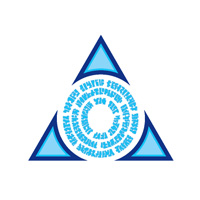 |
I am Azorius. I work to change the world into the world I believe it ought be. I believe that government can protect people from harmful elements in human nature and nongovernment organizations. Logic should temper passion, and so change should be slow precisely because we must understand that which is our desired end. |

